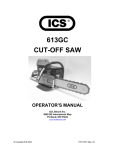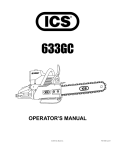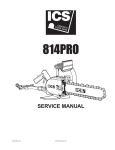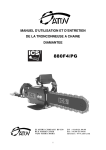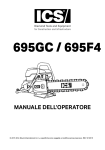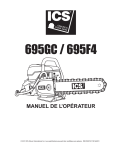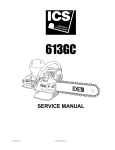Download Blount 853PRO User's Manual
Transcript
853PRO Hydraulic Saw OPERATOR’S MANUAL © 2008 ICS, Blount International Inc. Specifications are subject to change without notice. REV0708 F/N 71904 853PRO OPERATOR’S MANUAL TABLE OF CONTENTS SYMBOLS & LABELS 4 SAFETY 5 TECHNICAL SPECIFICATIONS 7 SET-UP 8 OPERATION 10 MAINTENANCE 12 TROUBLESHOOTING 14 REFERENCE 15 © 2008 ICS, Blount International Inc. Specifications are subject to change without notice. REV0708 F/N 71904 3 SYMBOLS & LABELS 853PRO OPERATOR’S MANUAL THE FOLLOWING SYMBOLS AND DEFINITIONS ARE FOUND THROUGHOUT THIS MANUAL AND ARE DESIGNED TO MAKE YOU AWARE OF POTENTIAL HAZARDS OR UNSAFE PRACTICES. WARNING A potentially hazardous situation exists which, if not avoided, could result in death or serious injury. CAUTION A potentially hazardous situation exists which, if not avoided, may result in minor or moderate injury or property damage. IMPORTANT A potential situation exists which, if not avoided, may result in product or property damage. THE FOLLOWING SYMBOLS & LABELS MAY BE FOUND IN THIS MANUAL OR ON THE SAW Read the operator’s manual carefully and understand the contents before you use this equipment. Always use: • Protective helmet • Ear protection • Protective glasses or full face protection Wear hand protection � WARNING • Do not exceed the hydraulic flow recommended for your saw model: 8 gpm, (30 lpm) or 12 gpm (45 lpm) at 2,500 psi (172.5 bar) hydraulic pressure • Minimum water pressure 20 psi (1.5 bar) • Weight 23 lbs (10.4 kg) w/out bar and chain • Inserting the tool into a pre-cut slot that is narrower than the chain may cause binding and rapid push-back of the tool toward the operator • Always operate tool with solid footing and firm hand grip • Contact at a hydraulic leak or burst can cause oil injection into the body READ OPERATIONS & MAINTENANCE MANUAL BEFORE USE OF TOOL. FAILURE TO OBSERVE THESE PRECAUTIONS CAN RESULT IN SERIOUS PERSONAL INJURY 4 © 2008 ICS, Blount International Inc. Specifications are subject to change without notice. REV0708 F/N 71904 853PRO OPERATOR’S MANUAL SAFETY THE FOLLOWING SYMBOL APPLIES TO ALL THE ITEMS LISTED ON THIS PAGE WARNING A potentially hazardous situation exists which, if not avoided, could result in death or serious injury. Diamond chain breakage can result in high-speed ejection of parts, which can result in death or serious personal injury to operators or bystanders. The items listed below are critical to minimizing the risk of diamond chain breakage and injury. • DO NOT operate a diamond chainsaw with a damaged, modified, broken or missing side cover, bottom guard or guard flap. The side cover, bottom guard and guard flap provides protection against contact with moving parts, ejected debris, broken diamond chain, thrown water and concrete slurry. • DO NOT operate saw with loose, missing damaged or improperly repaired parts. • DO NOT exceed the hydraulic flow for your saw model: 8 gpm (30 lpm) or 12 gpm (45 lpm) at 2,500 psi (172.5 bar) hydraulic pressure. • DO NOT install or run the chain backwards. The bumper should lead the segment into the cut. Bumper • DO NOT run the saw backwards. The chain should travel away from the operator on the top of the bar and return on the bottom of the bar. • DO NOT insert the diamond chainsaw into a slot narrower than the chain segments. Rapid pushback might occur. Ref: Most diamond segements are .225 (5.72 mm) wide. • DO NOT use the 853PRO side cover as a replacement cover for another saw. • DO NOT run the saw upside-down. Concrete debris can fly back into the operator’s face. • NEVER cut ductile iron pipe with the saw. Segment loss or diamond chain breakage may occur. • DO NOT use your hands to search for hydraulic leaks. Hydraulic fluid escaping under pressure can penetrate skin. If any hydraulic flud is injected into skin seek medical attention immediately. © 2008 ICS, Blount International Inc. Specifications are subject to change without notice. REV0708 F/N 71904 5 SAFETY 853PRO OPERATOR’S MANUAL THE FOLLOWING SYMBOL APPLIES TO ALL ITEMS LISTED ON THIS PAGE CAUTION A potentially hazardous situation exists which, if not avoided, may result in minor or moderate injury or property damage. • Always turn the saw OFF when performing maintenance on the saw including diamond chain tensioning. • Never use equipment that is not functioning properly. Have the saw repaired by qualified service personnel. • Diamond chains require a minimum water pressure of 20 psi (1.5 bar). Insufficient water supply may result in excessive wear to the diamond chain, which can lead to loss of strength and diamond chain breakage. • Never start the saw unless the guide bar, diamond chain and side cover are properly installed. GENERAL SAFETY PRECAUTIONS • Always wear protective clothing, including hard hat, eye protection, hearing protection, and gloves. • Avoid loose fitting clothing. • Perform safety checks before starting each day. • Always operate tool with solid footing and with both hands on cut-off saw. • Remove or control slurry to prevent slippery conditions while cutting. • Be sure there are no obstructions (plumbing, electrical conduit, air ducts) and no unnecessary people present. • Set up a well-marked safety zone with a roped boundary and clear signs. • Provide adequate ventilation when working in an enclosed area. Breathing exhaust gases is dangerous. • To avoid electrocution, check for live electrical wiring near cutting area. 6 © 2008 ICS, Blount International Inc. Specifications are subject to change without notice. REV0708 F/N 71904 853PRO OPERATOR’S MANUAL Technical specifications 853PRO 8 gpm (30 lpm) 853PRO 12 gpm (45 lpm) Weight w/out bar and chain 23 lbs (10.4 kg) 23 lbs (10.4 kg) Length 23 inches (58.5 cm) 23 inches (58.5 cm) Height 10.5 inches (26.5 cm) 10.5 inches (26.5 cm) Width 9.5 inches (24 cm) 9.5 inches (24 cm) Hydraulic Supply 8 gpm (30 lpm) @ 2,500 psi (172.5 bar) 12 gpm (lpm) @ 2,500 psi (172.5 bar) Hydraulic Fluid Requirements (Type) Mobil DTE 13M or equivalent Mobil DTE 13M or equivalent Water Pressure Minimum: 20 psi (1.5 bar) Minimum: 20 psi (1.5 bar) Water Flow 1 gpm (4 lpm) minimum 1 gpm (4 lpm) minimum Operating Speed 5,700 rpm (avg. free running) 4,800 sfm (avg. free running chain) 5,300 rpm (avg. free running) 4,500 sfm (avg. free running chain) Noise Level 88 dB @ 3 ft (1 m) 88 dB @ 3 ft (1 m) Vibration 4 m/sec² (front handle) Ref. ISO standard no. 7505 4 m/sec² (front handle) Ref. ISO standard no. 7505 Torque 130 in-lbs (176 Nm) 207 in-lbs (280 Nm) Horsepower 11.5 hp (8.6 kW) 17.5 hp (13 kW) © 2008 ICS, Blount International Inc. Specifications are subject to change without notice. REV0708 F/N 71904 7 Set-UP 853PRO OPERATOR’S MANUAL GUIDE BAR AND DIAMOND CHAIN INSTALLATION STEP 1 Loosen the side cover nuts and remove the side cover. STEP 4 Mount the chain on the bar starting at the drive sprocket & continue over the bar nose. Install the chain correctly. The bumper must always lead the segment into the cut as shown here. STEP 2 Place the bar onto the studs and the chain adjustment pin. STEP 3 Turn the chain-tensioning screw CCW until the bar comes into contact with the drive sprocket. 8 STEP 5 Make sure all of the drive links are inside the bar groove, then pretension the chain. © 2008 ICS, Blount International Inc. Specifications are subject to change without notice. REV0708 F/N 71904 853PRO OPERATOR’S MANUAL Set-UP GUIDE BAR AND DIAMOND CHAIN INSTALLATION STEP 6 Install the bar clamp plate over the bar studs. STEP 8 Tension the chain. Do not over tension the diamond chain. Loss of power will result. It is normal for the drivelinks to hang underneath the guide bar. The diamond chain should be snug but be able to be pulled around the guide bar by hand. STEP 7 Install the side cover over the bar studs and install side cover nuts. Finger tighten only. STEP 9 Lift up on the nose of the bar and firmly tighten the side cover nuts. To prevent chain tensioner breakage, be sure the side cover nuts are tightened to approximately 20 ft-lbs (27 Nm). © 2008 ICS, Blount International Inc. Specifications are subject to change without notice. REV0708 F/N 71904 9 OPERATION 853PRO OPERATOR’S MANUAL PRE-CUT CHECKLIST • Proper Diamond Chain Tension: The diamond chain should be tight but easily pulled around the guide bar by hand. • Ensure all safety devices are properly mounted and functional and that all controls are in proper working order. • Be sure there are no obstructions (plumbing, electrical conduit, air ducts). • Always wear protective clothing, including hard hat, eye protection, hearing protection, non-slip safety boots, gloves, and avoid wearing loose fitting clothing. • Adequate Water Supply and Pressure 1 gpm (4 lpm) recommended flow Minimum water pressure 20 psi (1.5 bar) Note: The single most important factor an operator can control to increase chain life is to use adequate water pressure. Insufficient water supply will result in excessive wear to the chain, which can lead to loss of strength and chain breakage. • Proper Hydraulic Supply to the saw Maximum Flow 8 gpm (30 lpm) or 12 gpm (45 lpm), depending on saw model Maximum Hydraulic Pressure 2,500 psi (172.5 bar) PLANNING THE CUT • Outline the cut with a permanent marker for a visual cutting guide. • Avoid pinching the guide bar and diamond chain. Always cut the bottom of an opening first, then top, and then the sides. Save the easiest cut for last. • For the straightest cuts use the “Step Cut” method. First score the entire cut line approximately a 1/2 inch (12 mm) deep using the nose of the guide bar. Next, deepen the cut by about 2 inches (50 mm). Then plunge all the way through and complete the cut using the WallWalker ®. • Be sure cut concrete cannot fall and injure operator or bystanders. Concrete is very heavy, one cubic foot = 12 in x 12 in x 12 in = 150 lbs (30 cm x 30 cm x 30 cm = 68 kg). • Check for live electrical wiring near the cutting area or in the concrete to avoid electrocution. 10 © 2008 ICS, Blount International Inc. Specifications are subject to change without notice. REV0708 F/N 71904 853PRO OPERATOR’S MANUAL OPERATION CUTTING TIPS • To start a cut, hold trigger on full throttle and slowly plunge the nose of the guide bar straight into the wall. Use the fixed WallWalker ® as a pivot point and pull up on the rear handle to rotate the guide bar into the cut. • Always operate the saw at full throttle. Apply enough feed force so that the free running RPM drops 20 to 30%. If too much force is applied, the saw will lug or stall. The diamond chain will not have enough speed to cut effectively. If too little feed force is applied, the diamonds will skid and glaze over. • For straighter cuts use the “Step Cut” method. First score the entire cut line with the nose of the guide bar approximately 1/2 inch (12 mm) to 1 inch (25 mm) deep. Next, deepen the cut by about 2 inches (50 mm). This groove will help guide the guide bar for a straight cut. Then plunge all the way through and complete the cut using the WallWalker ®. • Use the WallWalker ® to help cut more efficiently and reduce operator fatigue. The WallWalker ® is a fulcrum that converts inward force to downward force and will develop a 4-to-1 mechanical advantage. To use correctly, plunge into the wall and simply engage the point of the WallWalker ® into the cut and push straight in. The WallWalker ® will force the saw to feed down. • Apply upward force on the trigger handle to keep the WallWalker ® engaged properly, otherwise the WallWalker ® pick will skid, which will reduce the effectiveness. As the saw begins to rotate up, feed force is developed down the line of the intended cut. Once the saw is fully rotated upwards, pull the saw out of the cut a few inches and re-engage the WallWalker ® to the wall and repeat. • When cutting rebar, slowly rock the saw so that you’re always cutting concrete as well as steel. This will help keep the diamonds exposed. Also, expect less diamond chain life when cutting rebar. • Expect more diamond chain stretch and guide bar wear when making “nose buried” cuts for extended periods of time, as the diamond chain does not have a chance to throw the slurry away from the nose of the guide bar. • If the saw begins to cut consistently crooked, turn the guide bar over and use the other side. Dress worn rails with belt sander. Note: The normal life of a guide bar is two to three diamond chains. Rebar can shorten guide bar life. • When using a new diamond chain, you can increase the cutting speed by opening up the diamonds by making a few cuts in an abrasive material such as a cinder block. © 2008 ICS, Blount International Inc. Specifications are subject to change without notice. REV0708 F/N 71904 11 MAINTENANCE 853PRO OPERATOR’S MANUAL SYSTEM CLEAN-UP • After cutting, run the saw for at least 15 seconds with the water on to flush slurry and debris from diamond chain, guide bar and drive sprocket. • Wash concrete slurry from saw assembly. • Avoid getting any water in the carburetor or exhaust system. If water enters exhaust port, point the guide bar tip down and pull the starter handle several times to expel water from muffler. • Remove guide bar and diamond chain. Flush out the chain tensioner with high water pressure and lube with grease. • After cleaning the saw, spray the entire saw body, diamond chain, guide bar, and drive sprocket with lightweight oil. Using lightweight oil on the saw will minimize rust and help reduce slurry build up. 12 © 2008 ICS, Blount International Inc. Specifications are subject to change without notice. REV0708 F/N 71904 853PRO OPERATOR’S MANUAL MAINTENANCE TITLE DRIVE SPROCKET REMOVAL • STEP 1 – Prevent the sprocket from rotating by inserting the scrench or screwdriver through the holes in the sprocket and the hole in the saw body. • STEP 2 – Loosen the Trantorque® using a 7/8 in box end wrench. NOTE: Slurry will accumulate inside the Trantorque® adaptor while cutting. This can fill expansion spaces and make it difficult to remove. To faciliate removal, turn the hex nut counterclockwise approximately 1/8 turn, and then turn it clockwise slightly, so the hexnut is loose. Then lightly tap the end of the ring inside the hex nut several times with your box wrench. (This will loosen the slurry and allow the components to slide for removal). Continue to turn the hex nut counterclockwise to free the sprocket and Trantorque®. DRIVE SPROCKET INSTALLATION • STEP 1 – Clean the drive shaft and Trantorque® surfaces well before installation (Isopropyl alcohol is reccommended, to remove grease or hydraulic fluid). Note: Do not lubricate Trantorque® or shaft as slippage may occur. • STEP 2 – Slide the Trantorque® shaft adaptor onto drive shaft until it bottoms on the shaft. Note: Do not lubricate Trantorque® or shaft as slippage may occur. • STEP 3 – Slide drive sprocket onto the Trantorque® until it hits the bottom of the shaft. • STEP 4 – While holding the sprocket and Trantorque® as close to the frame of the saw as possible, finger tighten Trantorque® shaft adaptor. • STEP 5 – Stop the sprocket from rotating by inserting a scrench or screwdriver through the holes in the sprocket and the hole in the saw body. • STEP 6 – Tighten the Trantorque® shaft adapter with a torque wrench and a 7/8 in socket to 200 in-lbs (22.6 Nm). When a torque wrench is not available, use a 7/8 in box end wrench and tighten one-half turn past finger tight. Note: Do not turn around or reverse the direction of the drive sprocket to extend sprocket tooth life. Damage to chain or drive links may occur. © 2008 ICS, Blount International Inc. Specifications are subject to change without notice. REV0708 F/N 71904 13 TROUBLESHOOTING 853PRO OPERATOR’S MANUAL TROUBLESHOOTING • SLOW DIAMOND CHAIN SPEED – Be sure the powerpack is providing the correct hydraulic pressure and flow depending on your saw model (8 gpm / 30 lpm or 12 gpm / 45 lpm at 2,500 psi / 172.5 bar). • POOR CUTTING SPEED – The diamonds may be glazed over. Make a few cuts in an abrasive material such as a cinder block to expose the diamonds. • PREMATURE CHAIN STRETCH – Not enough water pressure. The minimum water pressure is 20 psi (1.5 bar). Insufficient water supply will result in excessive wear on the chain, which can lead to loss of strength and chain breakage. • CHAIN TENSIONER BREAKAGE – Side cover nuts are not tight enough. Torque to 20 ft-lbs (27 Nm). • WATER NOT FLOWING – Water hose is kinked or supply is not turned on. • MOTOR WON'T TURN – Hydraulics are hooked up backwards or powerpack is set on reverse flow. Further questions? Call 800.321.1240 or visit our website at: icsbestway.com 14 © 2008 ICS, Blount International Inc. Specifications are subject to change without notice. REV0708 F/N 71904 853PRO OPERATOR’S MANUAL REFERENCE APPROXIMATE CUTTING RATES Material Cutting Rate Concrete – 6 in (15 cm) 5 lineal in/min (12 cm/min) Red Brick – 6 in (15 cm) 10 lineal in/min (25 cm/min) Rebar – #4 (12 mm) 10–20 seconds through each piece INCH-FOOT DEFINITION An in-ft is a measure of how much material is to be cut. An in-ft is defined as: depth in inches times length in feet. Note: 129 in-ft = 1 m2 Example: How many in-ft are in this doorway? 1. Determine the depth of the cut in inches. For this example, 8 inches. 2. Determine the length of the cut in feet. 3+7+3+7=20 feet 3. Multiply the two numbers 8 in x 20 ft = 160 in-ft © 2008 ICS, Blount International Inc. Specifications are subject to change without notice. REV0708 F/N 71904 15 REFERENCE 853PRO OPERATOR’S MANUAL PERFORMANCE LOSS VS. HYDRAULIC HOSE LENGTH ASSUMPTIONS: • 8 gpm (30 lpm) or 12 gpm (45 l/min) flow at 2,500 psi (172.5 bar) • Zero elevation change • 2 pairs of flush-face fittings per hose 16 © 2008 ICS, Blount International Inc. Specifications are subject to change without notice. REV0708 F/N 71904 853PRO OPERATOR'S MANUAL ICS, Blount Inc. 4909 SE International Way Portland, OR 97222 Tel 800.321.1240 Fax 503.653.4393 icsbestway.com © 2008 ICS, Blount International Inc. Specifications are subject to change without notice. REV0708 F/N 71904

















